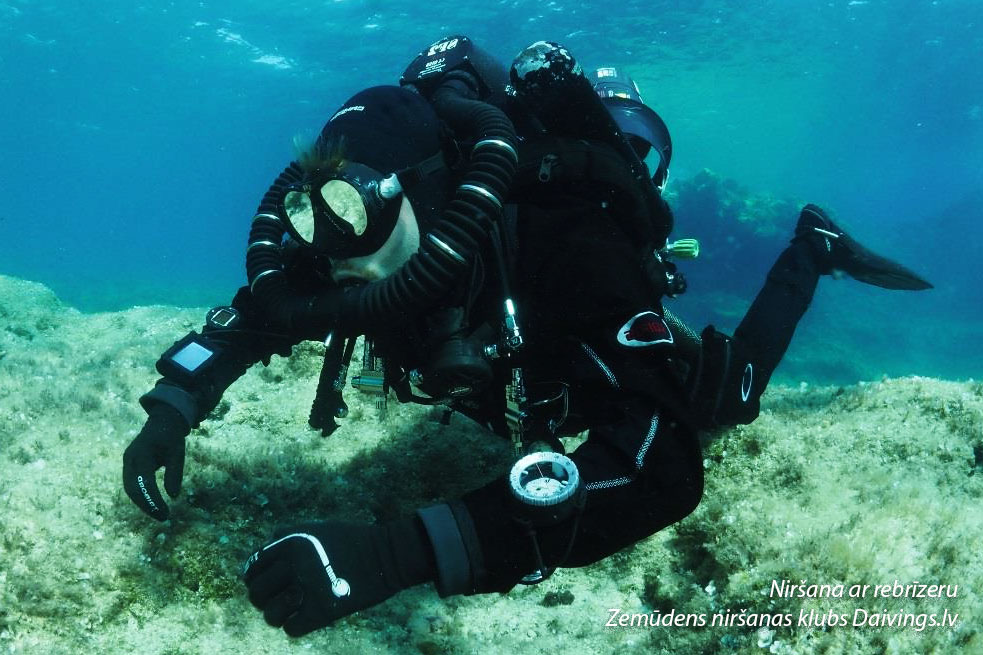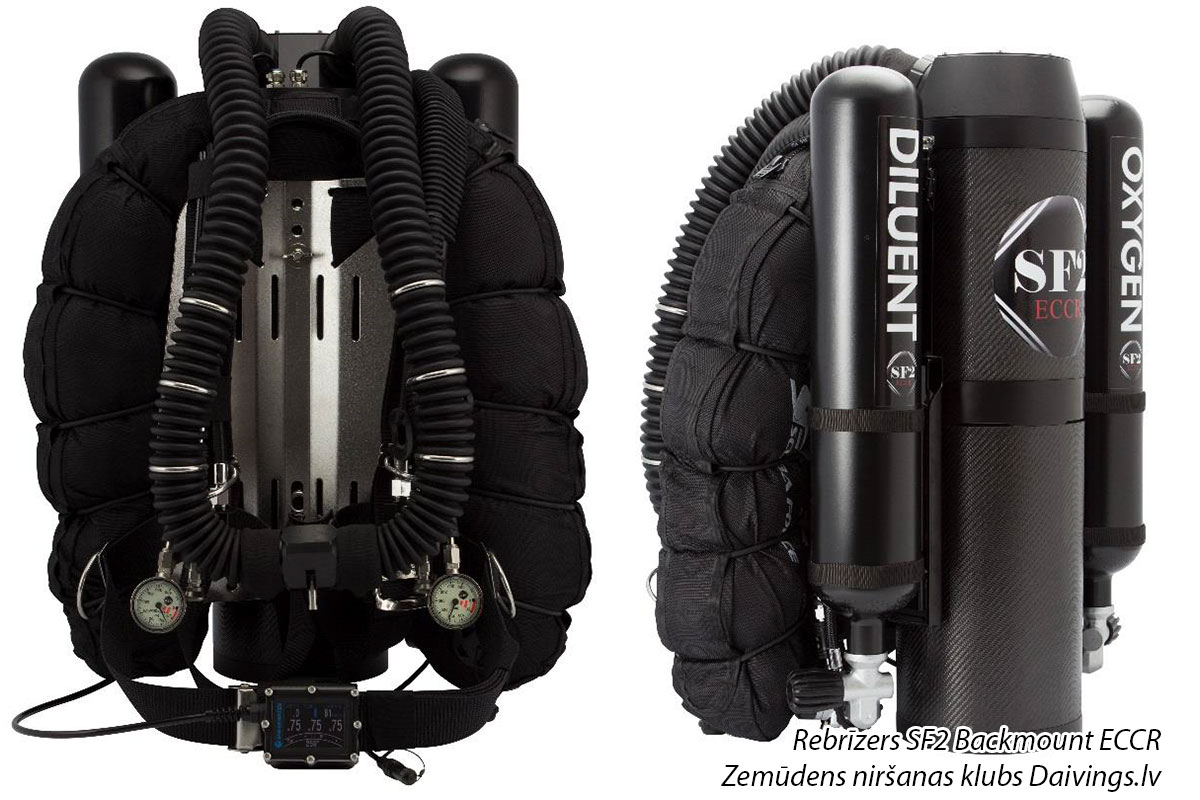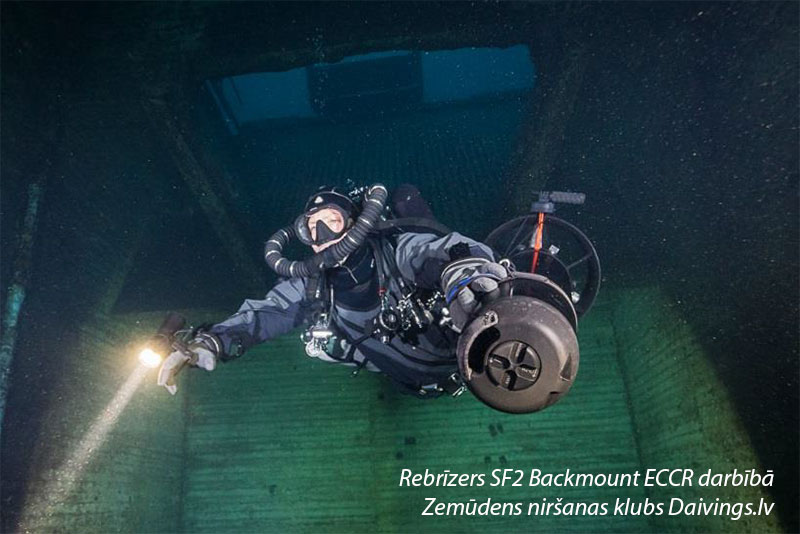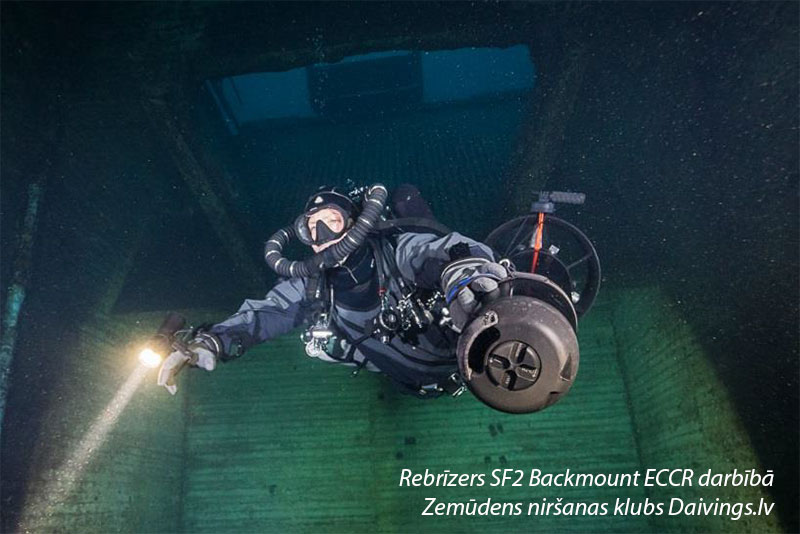Underwater diving club "Diving" instructor, PADI MSDT technical divings coach Valters Preimanis says about the use of vibrators for scuba diving: The Rebriser is intended only for experienced, certified divers who have been trained to use the breathing system of a particular model, or for those divers who are undergoing training and are under the direct supervision of a qualified instructor. Even if you have experience in using underwater equipment, you should take the time to acquire knowledge in special courses. The reefer is intended for use by certified scuba divers who have completed a rebeer course or who are trained and supervised by a qualified instructor.
Table of Contents
How the rejuvenator works
We will describe a modern reedger made in Germany SF2 Backmountbelonging to the ACR (Closed Cycle Rewriter) category, which can also be used in a configuration SF2 Sidemount. The designation of the rejector in the international language is CCR (Closed Circuit Rebreather). It is a fully enclosed system in which only the metabolized oxygen used (consumed) is added. In the reedger, unlike the design, this can be done manually (described as MCCR) or electronically, as with the SF2 Backmount ECCR.
SF2 is the ECCR's electronic closed-circuit rejector, its basic principle is in fact relatively simple, and it has been tried and tested for decades. The oxygen (O2) content of the breathing gas is measured using three independent oxygen sensors. If the proportion of oxygen in the breathing gas falls below a pre-set value, oxygen enters the system through an electronically controlled solenoid valve (solenoid) until it returns to the set value.
What sounds simple in theory is practically influenced by various factors, such as an increase or decrease in pressure when descending or taking off.
The main advantages of the reedger in diving
- You have no outgoing air bubbles
- Large amount of breathable air, up to <8 hours under water
- You breathe warm air, which increases the diver's time under water

Diving with a rejuvenator is exciting, but knowledge and skills are important to make it safe. We believe that a well-trained diver is one who is willing to engage in continuous training and safe training programs to improve their skills. Diving equipment, including a vibrator, is a tool that a diver must learn, not the other way around.
Comparison of the reefer with ordinary diving equipment
Unlike an open-loop system, a diver with an SF2 Backmount ECCR does not release any gas during the dive because he breathes in a closed circuit that explains the name. (If there is overpressure in the respiratory system, for example during take-off, air gas is released into the environment even with a closed breath.)
Keeping this chain in good working order is important and should be checked before each dive. With Backmount ECCR directional membranes, located in the mouthpiece. From the diver's point of view, ie with the device on the back, the gas flows from right to left.

Our body consumes (metabolizes) the oxygen we breathe. It produces carbon dioxide - CO2. When we breathe, we usually release this gas into the environment. But because our respiratory chain is closed, CO2 also remains in the system. Hypercapnia, ie an increase in the level of carbon dioxide in the blood (approximately 45 mmHg), can quickly lead to life-threatening situations, especially underwater. To prevent this, the CO2 obtained is bound in a tank with soda lime.
Rebriser lime storage and operation
The life of the main component of the rejuvenator used, the purifier lime, or scrubber, depends on many different factors. Absorbency depends mainly on its type or manufacturer, but storage, filling of the scrubber, immersion conditions, temperature, effort, etc. Many factors have a major influence on the nominal values of soda-lime determined under standard conditions.
Rebriser lime storage
Moisture is required to start the calcium reaction (CO2 reacts with water to form carbonic acid). Therefore, soda lime contains 14-20% of water. Improper storage leads to drying and thus to loss of reactivity of the lime. If fresh lime is not stored airtight, it will be dry by 4 weeks at the latest. In addition, lime would sequester CO2 from the air and thus lose its absorption capacity. Therefore, you should not leave the scrubber filled for too long. It is good for repeated diving on the weekend, but it should be replaced after 2 weeks at the latest.

Effect of temperature on soda lime performance
The working time of the reeds' fine lime depends in particular on the temperature. The lower the ambient temperature, the worse the calcium reaction. This means that the performance of the soda lime filter is significantly lower in cold water than in hot water. The tank, filled and used in warm Mexican waters, could be used for 6 hours. The same tank, filled and used at 37 degrees Fahrenheit (3 ° C) in a cold mountain lake, would suffice for 3 hours. At 20 ° C the filtration rate of lime is 100%, at 15 ° C it drops to about 80%, at 10 ° C it drops to about 65% and at 4 ° C it drops to less than 50%. With regard to temperature-dependent filtration performance, it is important to note that the filtration rate per unit time is meant here. Lime is not consumed faster in the cold, but only reacts more slowly or the reaction zone becomes larger.
Duration of reefer scrubber operation
According to the soda lime manufacturer, 1 kg of soda lime can be bound approx. 110-150 l CO2. The approximate lime time can now be calculated using metabolism. The scrubber scrubber can hold up to 2.2 kg. The theoretical CO2 absorption capacity is approximately 330 l CO2. (2.2 x 150). Typically, one produces 1-1.5 l / min of oxygen or CO2, which corresponds to about 100 watts of physical activity. This means that the theoretical lime filtration time is about 3.5 hours (330 / 1.5 = 220 min).

Rebrisor oxygen sensors
Since the oxygen content in the gases of the respiratory system must be repeated and constant, several oxygen sensors are used for it, confirms PADI MSDT technical diving coach Valters Preimanis. To increase the safety and accuracy of O2 measurements, the ECCR has three built-in oxygen sensors. The sensors are located in the head, where they are well protected and yet easily accessible. The measured values are continuously transmitted to the controller, which then adjusts the set value with the help of an electromagnet if necessary. If one sensor becomes faulty, it is switched off by the hardware using the controller logic. Nevertheless, two sensors are still available and diving can be stopped. There are many different types of oxygen sensors, however galvanic oxygen sensors are designed for use in diving for many reasons. They are designed as a complete unit and are discarded and replaced when internal components are used up.
Calibration of the sensors is very important to display the correct partial pressure of the oxygen in the breathing gas under water. The ECCR shall be calibrated with pure oxygen and at least weekly or as external conditions change. If the air pressure changes (for example, diving in a mountain lake or in case of large weather fluctuations), it must be recalibrated. Even if the head of the rejector cylinder has been serviced, if water has entered the head or if something was noticeable during the last dive, it must be calibrated.
About Backmount ECCR in Latvia
SF2 manufacturer in cooperation with the diving club "Diving" it is possible to purchase a reefer if you have completed a training course and have an SF2 Backmount ECCR diving certificate, informs PADI MSDT technical diving coach Valters Preimanis.
SF2 is delivered already assembled. All essential components have already been assembled and tested. However, accessories such as oxygen cylinders, wings and regulators still need to be installed and in some cases adjusted to personal size (BCD). This takes place within the SF2 diving course under the direct supervision of a diving instructor. The reuser instructor provides practical advice and oversees the correct assembly of all components. This is the only way to ensure proper operation of the Backmount ECCR.
Backmount ECCR safety check
Function tests and checklist processing are essential for the smooth running of the ECCR. Even if the clean assembly is done in advance, the entire diving device should be inspected at the dive site and the checklist should be checked. Important functional tests are pressure tests for leaks in the system and control of hose direction, shut-off devices and connections. In addition, all valves (solenoids, ADV, OPV, MAV) must work properly and the controller must be switched on.
Even if you especially have a lot of experience with the vibrator, you should always develop tests and inspections using a short checklist. Checklists and SOPs (Standard Operating Procedures) are also for professionals! Here you can learn a lot from aviation and emergency medical care, where detailed incident and accident analysis and checklists have become indispensable.
PADI MSDT technical diving coach Valters Preimanis says about the use of reedbreakers for scuba diving: Accumulating experience, as well as proper disassembly and follow-up procedures, is important so that you can enjoy the ECCR for a long time and important components are not unnecessarily damaged.
Useful information:
- Technical diving Technical Diving Tec Sidemount PADI
- Contacts with the club WhatsApp 220-77-202, e-mail daivingslv @ gmail, com

